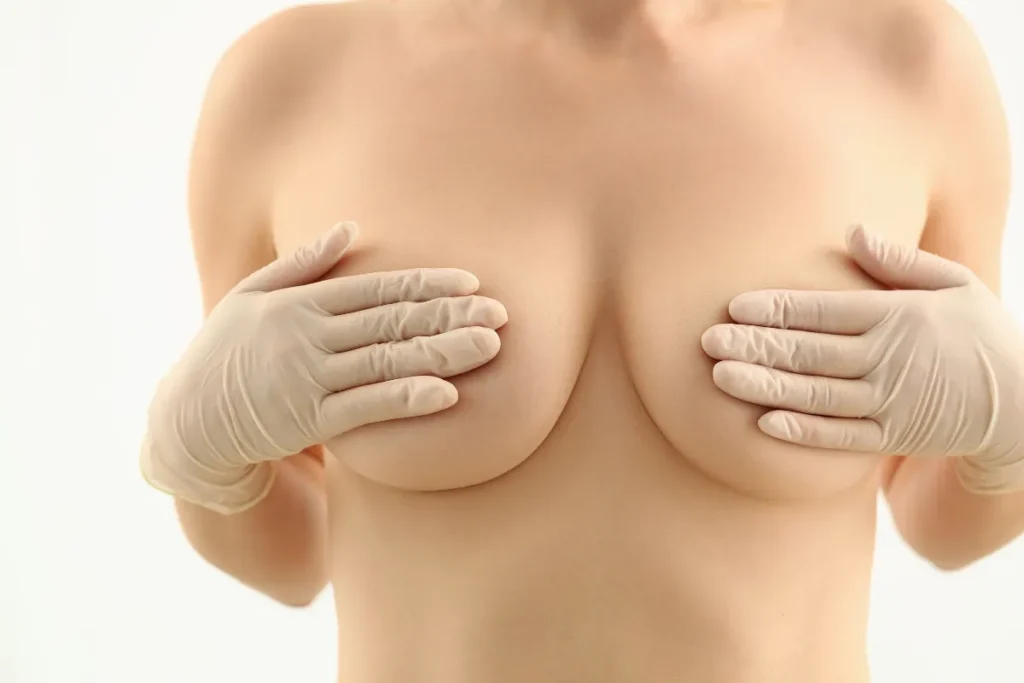Bottoming Out Breast Implant: Causes and Fixes
By Partington Plastic Surgery on August 18, 2025 in Breast Augmentation, Breast Implants

Breast augmentation has become one of the most popular cosmetic procedures. While most women enjoy their results for many years, complications can happen. One of these issues is a bottoming out breast implant.
This condition affects the appearance and comfort of the breasts. It can happen soon after surgery. It can occur years later. Knowing the breast implant bottom out signs early can help you get the right treatment.
Let’s explore what it is, why it happens, how to fix it, and what the breast implant bottom out repair cost might be. We also answer common questions, like how much does it cost to replace breast implants.
Bottoming Out Breast Implant
A bottoming out breast implant occurs when the implant slips too low on the chest. This causes the nipple to appear higher on the breast and changes the breast shape. The natural fold under the breast – called the inframammary fold – moves downward.
In many cases, the lower part of the breast looks stretched. The implant sits too low, and the upper part of the breast appears emptier.
It’s different from normal settling after surgery. In the breast implant settling process, implants drop gradually into place. With bottoming out, the drop is too much and in the wrong direction.
Breast Implant Bottom Out Signs
The breast implant bottom out signs can vary, but the most common include:
· Nipples appearing unusually high on the breast.
· A stretched or lowered breast fold.
· More fullness at the bottom of the breast than at the top.
· Implants feeling like they sit too low in the bra.
· Pain or discomfort in some cases.
If you notice one or more of these breast implant bottom out signs, consult your plastic surgeon. Early action can prevent further changes.
Natural Look
Confident Beauty
24 Hour Rapid Recovery, Muscle Sparing.

Causes of Bottoming Out
A bottoming out breast implant can happen for a variety of reasons. In most cases, it’s the result of a combination of factors. The breast tissue and surgical outcome are impacted by them. Knowing these causes can help you avoid the problem. This helps to recognize breast implant bottom out signs early.
Surgical Technique Issues
One of the most common causes is related to how the surgery was performed.
· The implant pocket can be made too large. So, the implant has extra room to move downward.
· Over-dissection of the lower breast fold during surgery can weaken its natural support.
· Placing the implant too low during the initial surgery can also lead to a bottoming out breast implant soon after recovery.
Surgeons with extensive experience know how to position the implant correctly. They reinforce the breast fold for long-term stability.
Oversized Implants
Too large Implants for a patient’s natural anatomy put extra weight and tension on the skin and tissue.
· Larger implants stretch the lower pole of the breast more aggressively.
· This can speed up the weakening of the inframammary fold.
· Gravity works harder on bigger implants. This increases the chance of the implant sliding down over time.
You need to discuss implant size. Balancing aesthetics with the health of the breast tissue becomes important. This helps to avoid breast implant bottom out signs later.
Thin or Weak Tissue Support
Some women natively have thin breast tissue. Some have skin with reduced elasticity. This can be due to genetics and weight fluctuations. Aging also influences the skin’s properties.
· The tissue can’t support the implant properly. As a result, the fold beneath the breast may drop.
· Skin has been stretched from pregnancy. This effect can also occur after significant weight loss. The skin becomes especially vulnerable.
Enough tissue strength is needed. In other cases, even a perfectly placed implant can eventually bottom out.
Placement Above the Muscle (Subglandular)
Implants can be placed above the chest muscle. They rely entirely on skin and glandular tissue for support.
· In cases of thin tissue, the downward pull of gravity can be too strong.
· Over time, this can cause a bottoming out breast implant much faster than submuscular placement.
Healing and Post-Surgery Activity
The weeks after breast augmentation represent an important period for healing.
· The healing tissues can be strained by lifting heavy objects and high-impact movements.
· You need to use the recommended surgical bra and support garment. Ignoring this aspect can also reduce the stability of the implant pocket.
These mistakes can weaken the lower breast fold. This makes bottoming out more likely.
Aging and Changes in the Body
Age can cause breast implant bottom out signs even after a flawless procedure and maintenance.
· Elasticity of the skin is reduced over time.
· Breast tissue can be affected by hormonal changes and breastfeeding.
· The skin can be stretched by weight gain and loss.
These changes can cause the implant to shift lower and the breast fold to drop.
Capsular Contracture and Tissue Changes
Scar tissue changes can contribute to a bottoming out breast implant in some rare cases.
· The scar tissue around the implant can form unevenly. It can become too thin in certain areas. In these cases, the implant may move downward.
· Revision surgeries and procedures to deliberately change the capsule increase the likelihood of this happening.
This wider explanation makes it clear – bottoming out is not caused by one single factor. Often, it results from a mix of surgical and other elements. You need to recognize the dangers early. This can help you and surgeons make proper choices. This reduces the probability of developing breast implant bottom out signs in the future.
Diagnosing Bottoming Out

Your surgeon will examine your breasts. The specialist will check for breast implant bottom out signs. They may compare your before-and-after photos and measure the position of the nipple. They look at the breast fold.
In some cases, one breast may bottom out more than the other. This creates unevenness in shape and nipple height.
Fixing a Bottoming Out Breast Implant
However, a bottoming out breast implant can be repaired. The right solution depends on the cause and your goals.
Surgical Repair
The most common solution has become breast implant surgery. This involves reinforcing and recreating the breast fold to support the implant. Your surgeon may also use internal sutures and a surgical mesh for added support.
In some cases, the bottomed out breast implant is replaced with a smaller one. This helps to reduce weight and strain on the tissue.
Implant Replacement
The implant can become damaged. You can want a different size. For such situations, your surgeon may recommend breast implant removal and replacement. As a result, the how much does it cost to replace breast implants question comes in.
The breast implant bottom out repair cost varies depending on the complexity of the breast implant revision surgery, the surgeon’s expertise, and the materials used.
Breast Implant Bottom Out Repair Cost
The breast implant bottom out repair cost is not the same for everyone. Let’s explore some special factors:
· Skill and experience of the surgeon.
· Type of implant used.
· Whether surgical mesh or other support materials are needed.
· Hospital or clinic fees.
In the U.S., the breast implant bottom out repair cost can range from $5,000 to $10,000. This often includes anesthesia and facility fees. And follow-up care is included.
You are ready to replace implants entirely. In this case, you might wonder, how much does it cost to replace breast implants? Breast implant replacement alone can range from $4,000 to $8,000. The price is impacted by the type and size of the implants.
Recovery After Repair
The recovery after fixing a bottoming out breast implant is similar to the original augmentation. You will need to wear a supportive surgical bra. You are advised to avoid heavy lifting and strenuous exercise. You are recommended to sleep on your back. This will help to avoid pressure on the breasts. You need to follow your surgeon’s massage and care instructions.
Full recovery can take several weeks, but most women return to normal activities within 4–6 weeks.

Preventing Bottoming Out
Not every case can be prevented. However, you can lower your threat.
· Choose a board certified plastic surgeon with great experience.
· Select proper implant sizes. They must suit your body and tissue strength.
· Follow all post-surgery care instructions.
· Wear supportive bras regularly.
· Avoid sudden weight changes because they can affect skin elasticity.
These steps can reduce your chances of experiencing breast implant bottom out signs in the future.
Emotional Impact of Bottoming Out
A bottoming out breast implant isn’t just a physical issue. Confidence and comfort can be affected. After the transition, many women become self-conscious about their breasts.
You can gain a better idea of what’s achievable with the help of your surgeon. You can look at photos of repairs before and after the breast revision surgery. The outcomes of a repair procedure often outstrip those of the initial augmentation.
Insurance and Costs
In most cases, cosmetic surgery repair costs will not be covered by insurance. Commonly, patients must pay out of breast pocket for the cost of breast implant bottom out repair.
Some insurance plans, however, may pay for a portion of the cost. This can occur in case the bottoming out has become the result of a medical condition. Severe capsular contracture and implant rupture can be covered.
You commit to a full replacement. In such a case, you are advised to receive an accurate estimate of how much it will cost to replace your breast implants.
Repair surgery can restore look and comfort. You are advised to choose the proper surgeon. You need to adhere to the post-op care instructions. This will give the best results.
Return to Overview